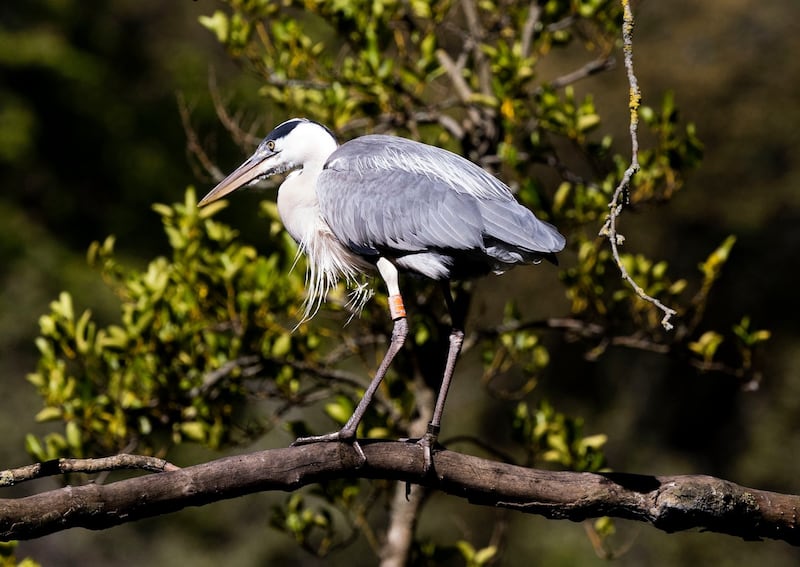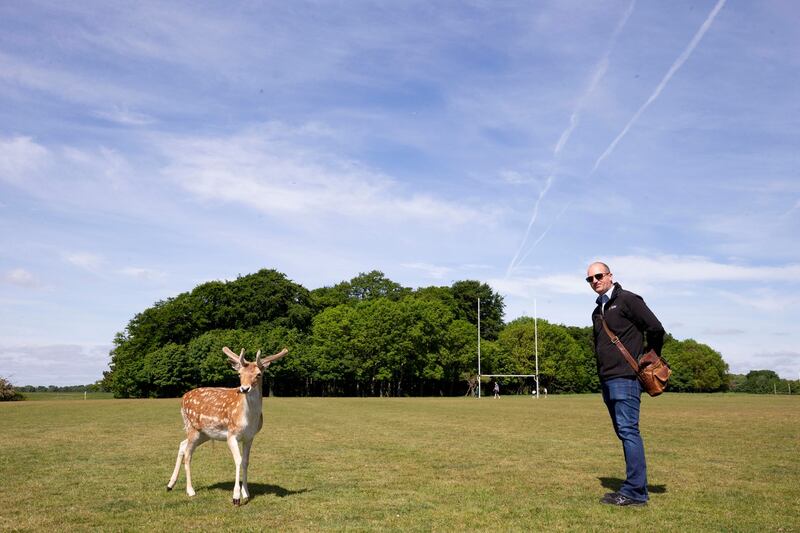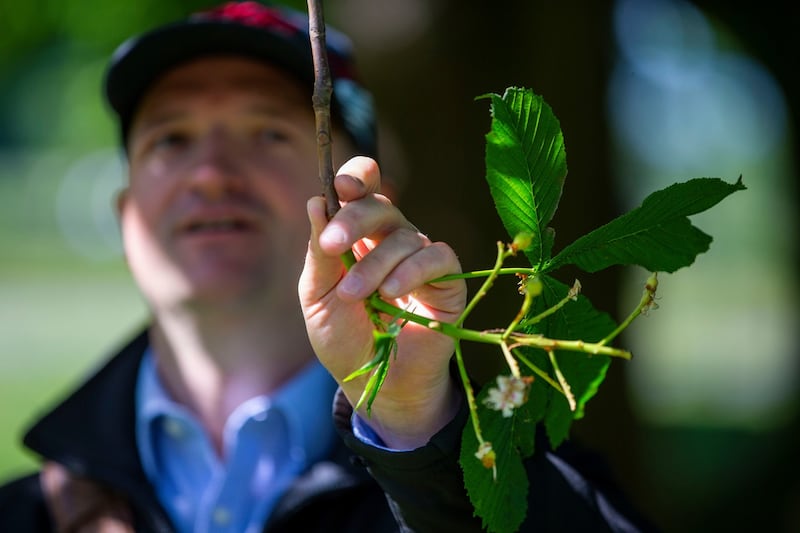"A lot of people think I must have changed my name but honestly it's the one I was born with," say Leif Barry as he talks about the broad leafed tree he is standing under in the Phoenix Park.
"I know Niall Hatch of Birdwatch Ireland well so I guess there's a pair of us in it," he adds with the weariness of a man who has heard far too many jokes about his name over the last three or four decades.
The appositely named environmental scientist and biodiversity expert with the Office of Public Works (OPW) has been working out of the park for more than five years and never once in that time did he imagine that he would one day see a change as dramatic as the one he has noticed in recent weeks.
“The cars have almost completely gone and there have been so many people walking in the park as everyone close by has looked to get outside even for short time during the lockdown,” he says.
“An awful lot of those people have commented on how loud the birdsong is. They are so much more aware of it now because the noise pollution has been completely removed. And I am not just talking about car traffic but planes too, and motor bikes and trucks reversing. It has been completely removed.”
Well, almost.

Safe haven
On the other side of the wild embankment bordering the People’s Park close to the Infirmary Road side of the park, a bus engine roars into life. Leif ignores it as he talks about the intentionally overgrown patch in almost full bloom.
“This is so important, it provides a safe haven for our pollinators and birds who can disappear if they want to.
“People look at it and wonder why it’s been left so wild,” he continues. “We have this thing in us that wants everything to be neat and tidy and squared away but it shouldn’t be like that.”
He points at the manicured grass nearby on which people are lounging in the sun. “That is the equivalent of a desert, and the wild patches here are the equivalent of an oasis.”
His tour takes in the 15 acres, an area of land that is actually 300 acres in size. It is where many of the faithful stood when the popes came to town
He says there will be, maybe, eight species of bumblebee, 14 species of butterfly as well as dragonfly and damselflies and more besides in this small patch alone.
Much of it is hard for the ill-educated eye to see. The heron standing haughtily near the lake in the People’s Park is hard to miss.
Many people come into this part of the park specifically to gawp at the pair of herons nesting nearby. As Barry talks, a couple try to set up a selfie with one of the birds who is having none of it. He’s gone before they can say cheese.
Well-meaning folk seeking moments of Insta glory with the park’s animals is a bugbear of Leif Barry’s.
The park’s deer were introduced in the 1660s as playthings for the Duke of Ormond, who used it as his hunting garden. “They were brought in because they were an awful lot more timid and easier to hunt than the red deer indigenous to Ireland.The royals would not have found hunting them so easy,” Barry suggests.
The deer are still pretty timid and can be coaxed into eating out of the hands of humans. This infuriates Barry. “People see pictures on social media of other people with the deer and want to replicate that,” he says.
The deer are fed carrots and apples and even Pringles, Taytos or ham sandwiches. “That is incredibly bad for them,” he continues. “By all means take their pictures but you don’t have to be in it. And please don’t feed them.”

‘Leave the deer alone’
Sometimes people do even more damage unwittingly. “We are coming into fawn season now, and what happens is the does leave their fawns in the long grass, they hide them and only return for feeding, but for those first few weeks the fawns don’t move and don’t make any noise,” Barry explains.
“Sometimes when the public stumble upon them they think they have been lost or abandoned. The fawns aren’t lost or abandoned, they have been left in the long grass on purpose. The problem is that people – good-natured people – will pick up fawns and bring them to rangers to try and get help but they leave a human scent on the fawn which can lead the mothers to reject them, so we always say leave the deer alone, they are fine.”
I fear that when we get back to normal business as usual, we might just get caught up in the rush of things again
The does and the bucks run in different herds and come together only for mating, with the females calling the shots and ultimately deciding who they will frolic with, leaving the bucks to try to impress them with their horn locking and rutting skills.
Even as they age, things don’t get much easier for the males. “The does, when they get old, tend to stay with their herds and maintain a maternal influence. The bucks go off on their own when they’re no longer in the game but they don’t give up on life,” he explains.
“They actually go to the grounds of the St Mary’s Nursing Home. It is rather strange,” he adds before his voice trails off.
While the deer are easy to see, the badgers are not. “We have at least three separate families of badgers here. I’ve seen them; some my colleagues never have. A lot of it is just down to chance.”
Bad fairies
There is little that Leif Barry doesn’t know about the park and its history.
“I always think it’s funny when I hear talk about when the park was built. The reality is it has been inhabited for at least 5,500 years,” he says as he climbs a steep hill to point out a prehistoric burial mound and dolmen you might never know existed unless it was pointed out to you.

"Brian Boru is known to have camped in Kilmainham in 1014 but it's most likely that he camped [at] the 15 acres over by the Magazine Fort. "
He talks about the trees – the oaks that can live for almost 1,000 years and the bewitched Elder Tree.
He points to a towering Californian redwood. “Feel that bark. It feels like sponge because it needs to survive Californian fires so the bark burns off quickly and then the flames move on, leaving the tree standing.”
His tour takes in the 15 acres, an area of land that is actually 300 acres in size. It is where many of the faithful stood when the popes came to town.
Some of the grass is mown and some is used for playing pitches. The longer grass is where the skylarks nest. “We have never found skylarks so close to an urban setting before,” Barry says.
As he talks he picks up a broken bottle of stout. There are no bins nearby. Should there be more, we wonder. “Would it matter if there were?” he responds. “Would the people who put that there have used a bin?”
His walk takes us to the Furry Glen, "This is our wildest section. He points to elder trees in full flower.
“It was considered a bad luck to break the branches in times past and it was thought that using the elder wood for fire would bring the bad fairies,” he continues. “You might think that is nonsense but it was only a long time later that scientists realised that burning elder wood gives off toxic smoke.”

Acting on biodiversity
His circuit moves past the US ambassador's home – Deerfield House – and Áras.
“Michael D has been one of the strongest advocates for biodiversity we could have hoped to see in there,” Barry says. “I remember him saying in a speech that we should all be leaders in our fields, and it was just so inspiring and it was almost as if he was giving us the go-ahead to shout about the importance of what we do and the importance of biodiversity.”
The speech Leif Barry refers to was delivered by the President at the first National Biodiversity Conference just over a year ago.
“Reversing biodiversity loss requires all of us to be leaders within our own spheres of influence – in our homes, our places of work, our circles of friends, our schools and universities, in our communities of place and of faith – to demonstrate the message that our biodiversity, our natural heritage, is our right, but also our responsibility,” the President said.
President Higgins hasn't just spoken about biodiversity, he has acted on it too.
Last year he commissioned a biodiversity survey of the grounds of Áras an Uachtaráin, which started last autumn. All was going well until Covid-19 brought everything to a halt.
Researchers from Trinity College Dublin were able to restart their project in the middle of the month, just ahead of National Biodiversity Week.
The survey is seeking to find ways to protect and improve the diversity of plant and animal life in the 130 acres of the Áras which include formal gardens, certified organic kitchen gardens, grasslands, wooded areas and a lake.
An exciting find
Dr Aoibheann Gaughran is a zoologist and part of the team carrying out the audit. She says the grounds are "not all beautifully manicured and it is a real nice mix of things: the formal gardens, broadleaf woodland, grasslands and a lovely little pond. We have been pleasantly surprised by how diverse it is and how much we are finding."
One of the things was a cave spider. “That was an exciting find. They are not commonly found so that was pretty cool.”
There are buzzards nesting, and two sparrowhawks and badgers have taken over a man-made tunnel and made it home.
“The President is very committed and he gets it,” she says. “There is a level of commitment you really want to see from people running the country and to have the president leading by example is a very visible symbol.”
Like Barry, she spends a lot of time in the Phoenix Park. “One of the really positive things about the lockdown is that people have been getting out and about and hearing the birds more and experiencing nature and noticing what is around them. I hope that will endure.
“I fear that when we get back to normal business as usual, we might just get caught up in the rush of things again. I hope people won’t take stuff for granted anymore after this.”


















